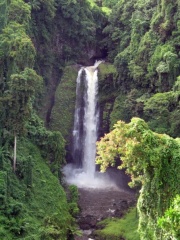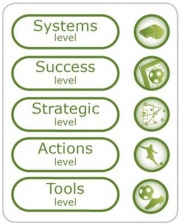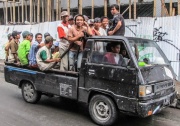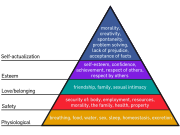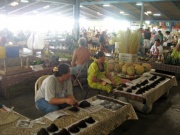Sustainable futures/ICSD/Learning
MICRO COURSE: The inspiring challenge of sustainable development
As the pressure builds and our global development continues to accelerate, our social, economic and environmental systems are falling further and further out of balance. Using a robust, yet simple, scientific foundation this module will enable the learner to explore and understand how these fundamental systems are connected, and how they are being placed under increasing pressure. This context then provides the setting for an effective strategic methodology that can enable us to imagine and create a future where our society thrives.
SESSIONS
- Sustainability is possible
- Understanding systems
- From the Holocene to the Anthropocene
- Defining sustainability and sustainable development
Contents
- 1 Session 1: Sustainability is possible
- 2 Session 2: Understanding systems
- 3 Session 3: From the Holocene to the Anthropocene
- 4 Session 4 - Sustainability and sustainable development defined: creating a good world
Session 1: Sustainability is possible
Objectives
In this learning session we will:
- Gain insights into what’s already possible by exploring examples of sustainable and symbiotic industrial design
- Learn how completely sustainable buildings are being built with the Living Building Challenge
Video Signpost
Introduction
The challenge of ‘sustainability’ and ‘sustainable development’ have been described by many as the most pressing challenge our species has ever faced. With over 7 billion people now living on our planet, the need to find a viable way for humans to prosper peacefully within ecological constraints is more important than ever.
A case for transformation
The institutions of business and industry have helped us achieve significant improvements to our quality of life over the last 250 years. Today, nearly everything we do is connected to economic activity of some sort, and the majority of social and environmental pressures we face arise from the way we run our economies.
The ecological, life-supporting systems of Earth have been in a balanced state of evolution for billions of years. Yet, over just the last 250 years technical progress and development of modern industrial systems, combined with rapid population growth have upset that balance.
The desired and ideal future is already possible
The challenge of sustainability is ultimately one of design. Can we design economic and industrial systems that maintain a social and ecological balance which enable humans to thrive within nature’s limits? We know already that this is possible.
From unsustainability to regeneration
Industrial symbiosis
In the Danish province of Kalundborg, a number of large businesses have been developing a system of industrial symbiosis that results in hyper-efficient resource use and almost no waste. In effect, the industrial cluster is designed in the same way as natural systems work: where the waste of one organisation is a raw material for another.
Living Buildings
Originally developed and launched by the Cascadia Green Building Council in 2006, the Living Building Challenge is acknowledged as the world’s most progressive and stringent green building code. It poses the challenge of designing buildings as nature designs. How do you create a building that harvests all its own water, produces all its own energy, and manages all its own waste-water on-site. These are just 3 of the 7 requirements for a fully certified living building.
There are currently 3 projects that have received full certification under the Living Building Challenge, with 4 others having been partially certified. As at October 2014, there are 90 projects currently in some phase of design, construction or operation.
References
Sources used in this session
- From Sustainability through Regeneration: Whole and Living System Design (video - 1:16:27), retrieved on 6th November 2014 from https://www.youtube.com/watch?v=BFzEI1rZG_U
- Kalundborg industrial symbiosis (video – 2:35 mins), retrieved on 6th November 2014 from https://www.youtube.com/watch?v=1yCYGOxnpSY
- Kalundborg industrial symbiosis in Denmark (website), retrieved on 6th November 2014 from http://www.symbiosis.dk/en
- Data for the living building section retrieved on 28th October 2014 from https://ilbi.org/about/faq#how-many-living-building.
- Video: The Living Building Challenge – Jason F McLennan (14:29 mins) https://www.youtube.com/watch?v=Sd6yUS8bjJY, retrieved on 6th November 2014
- Living Building Challenge videos (Jason F McLennan) (2:13) https://www.youtube.com/watch?v=zRYJOk28OrI&list=PLF6A73227CDF3D09B, retrieved on 6th November 2014
Additional resources
- Video: The Tuhoe Building in New Zealand (6:04 mins) - retrieved on 6th November 2014 from https://www.youtube.com/watch?v=mkHlJM6DpR0
- Book: Cradle to Cradle; by Michael Braungart and William McDonough (2010)
Session 2: Understanding systems
Objectives
In this learning session we will:
- Introduce the concept of systems thinking, and why this approach so critical to tackling issues of sustainability in an effective and meaningful way.
- Introduce the Natural Step’s Five Level Framework for an effective and strategic approach to sustainable development.
Video signpost
Introduction
Systems are everywhere. They are often complex because of the vast number of interrelationships and amongst and between different connected systems. Living systems have an added layer of complexity because they tend to evolve by adapting to external stimuli over time.
Many of the challenges we face as a society arise from the way our social and industrial systems currently operate. In many cases we may need to re-think the way entire industries operate, or re-conceive community governance structures if we are to design a way forward that is consistent with a sustainable and thriving future for our society.
What are systems and systems thinking?
Systems are sets of interacting and interconnected components or relationships that together form an integrated whole. Systems are everywhere and they are often complex. Every system is delineated by its spatial and temporal boundaries, surrounded and influenced by its environment, described by its structure and purpose and expressed in its functioning.
Systems thinking is the process of understanding how things, regarded as systems, influence one another within a whole. In nature, systems thinking examples include ecosystems in which elements such as air, water, plants, and animals work together to survive or perish. In organisations, systems consist of people, structures, and processes that work together to make an organisation "healthy" or "unhealthy".
Systems and unintended consequences
To create a sustainable and living future we need to address and ultimately eliminate the full range of adverse impacts currently arising in our society and environment that prevent people from being able to meet their needs and apply increasing pressure on resource availability and ecosystem health. This, fundamentally, is the challenge of sustainable development. And the solution lies in influencing current social and economic systems towards a sustainable paradigm.
Using a systems approach to foster sustainability
Sustainability challenges are complex because they arise from inter-dependent relationships where one party acting alone is usually unable to solve the challenge on their own. Lasting solutions require collaboration and careful design, or re-design, of systems.
For example, you might buy an electric vehicle to eliminate contributions of CO2 from using a petrol vehicle, but unless there are sufficient charging stations and other infrastructure in place, your ability to travel freely is restricted. Similarly, a government might pursue an approach to develop biofuel as an alternative to fossil fuels. To be successful, a reliable supply of bio-based raw materials, sufficient production facilities and a reliable distribution network are all required. All of those elements require investment and support from a range of different industry players that aligns decisions and action with the overall strategy. A systems focus can help identify all the different players required to achieve success, but how can we ensure they are all working towards the same end goal?
Systems thinking and a unifying framework for strategic sustainability
Strategy is about focusing on a desired outcome, and pursuing an approach that is calculated to produce it. Most organisations use strategic planning to frame a series of goals to work towards that will create their future. Traditionally, strategic planning has taken a narrow approach towards defining the desired success, at either an industry level or the company level. This approach has ignored the fact that companies and, indeed, entire industries are part of bigger systems that make up our society and the interwoven ecological systems that make up the biosphere.
Applying the Five Level Framework to smaller systems
The Five Level Framework can be applied to any defined system to differentiate between definitions of success (usually called a ‘vision’ in strategic planning processes), strategies, actions, and tools. As an example, consider the game of football.
Football is often described as the world's simplest game. Let’s apply the Five Level Framework to the game of football as a way of exploring how the framework for sustainable development might be used for considering any strategic approach.
The SYSTEM level defines the boundaries of the game: the rules of the game, the pitch, its goal posts and the people involved: players, referees, coaches and other support team members etc.
The SUCCESS level defines how to win, which is to score more goals than the other team. Simple!
The STRATEGIES to enable success are much more complex and involve creative thinking to score goals and win. This might include set piece moves, rehearsed interplay between players, and other agreed tactics.
The ACTIONS level is more specific and is the way the strategies go from being an idea to becoming real. Each person has a specific role to deliver the strategy, such as a the players being in certain places and the coach delivering the appropriate training regime, as well as the more operational roles such as preparing the pitch and running the touch line.
The TOOLS level covers all the equipment, systems and processes required for the actions, and to evaluate and monitor performance. So it includes the players’ boots, nets for the goals, a stopwatch to keep time, video refereeing equipment, and the processes for gathering performance statistics like shots on goals, tackles made, possession etc.
References
Sources used in this session
- http://en.wikipedia.org/wiki/System, retrieved on 29th October 2014
- http://en.wikipedia.org/wiki/Systems_thinking, retrieved on 29th October 2014
- Peter Senge video (5:17 mins) https://www.youtube.com/watch?v=HOPfVVMCwYg, retrieved on 6th November 2014
- UN Conference paper http://www.uncsd2012.org/content/documents/319TNS_InputsforDraft%20Zero_Rio20_1Nov2011.pdf, retrieved on 6th November 2014
Additional resources
- Book: The Fifth Discipline: The Art and Practice of the Learning Organization; by Peter Senge (2006)
- Video: How the Earth works (as seen from Space) (49:39 mins) - retrieved on 6th November 2014 from https://www.youtube.com/watch?v=W7kFl2KOhRA
Session 3: From the Holocene to the Anthropocene
Objectives
In this learning session you will:
- Learn how the ecological system works, and how humans are adversely affecting it
- Learn how the social system works
- Learn how humans have become the dominant shaping force on the planet
Video signpost
Introduction
The Earth is believed to have formed as a result of the Big Bang which created our Universe over 13 billion years ago. Earth is a closed system for matter. That means all the matter that formed Earth after that event is still here today (give or take the materials sent into space, and the arrival of meteorites).The Earth is composed mostly of iron (32.1%), oxygen (30.1%), silicon (15.1%), magnesium (13.9%), sulfur (2.9%), nickel (1.8%), calcium (1.5%), and aluminium (1.4%); with the remaining 1.2% consisting of trace amounts of other elements. Due to mass segregation, the core region is believed to be primarily composed of iron (88.8%), with smaller amounts of nickel (5.8%), sulfur (4.5%), and less than 1% trace elements.
Earth is the third planet from the sun and the densest in the solar system. Whilst being a closed system for matter, it is an open system for energy. Energy is delivered every day from the sun, and returned into space through radiation.
The biosphere is the global sum of all living systems on Earth. It is believed to have started forming over 3.5 billion years ago. The biosphere is the global ecological system integrating all living beings and their relationships, including their interaction with the elements of the lithosphere, geosphere, hydrosphere, and atmosphere.
Humans have evolved over millions of years as part of the biosphere. However, it was only about 12,000 years ago that we began to form communities around organised agriculture; and just 250 years since the start of the Industrial Revolution. In that small period of time, humans have rapidly spread across all corners of the planet and emerged as the dominant shaping force on the surface of the Earth.
How the Earth works
It was many billions of years after the Big Bang that the biosphere, and life on Earth, started to develop. Understanding how this process came about is essential to understanding how to maintain the delicate environmental balances that will enable life to prosper, sustainably, long into the future.
The Earth is a closed system for matter
The Earth is made up of chemical elements - think of the periodic table. That is a list of all basic elemental materials on our planet. Because of gravity, matter (comprising all solids, liquids and gases) does not leave the system. It is a closed box. And, the laws of thermodynamics, long agreed by scientists, tell us that it’s impossible to destroy matter. So the chemical matter we have on Earth will always be here. The important question is, how is that matter organised?
The Earth is an open system for energy
It is accepted science that the Earth is an open system for energy. Energy radiates into the Earth’s system, mainly from the sun. Energy is then radiated back into space from the Earth, with the flows being regulated by the Earth’s atmosphere and ozone layer. This delicate balanced transfer of energy maintains the surface temperature at a level that is suited to the forms of life that have evolved and currently exist.
Matter changes form, but never disappears
It’s tempting to think that the litre of gasoline you put in your car is simply burnt, and disappears. Not so. The process of burning gasoline simply strips out all the energy bonds holding different chemical particles together. The bonds in gasoline are particularly strong, hence the energy release is intense - which is the reason it has been so useful for humans. The chemical elements are transformed into gases and small particles with the same weight and mass as the gasoline that was burnt. These particles are difficult to see (and so easily overlooked) and almost impossible to contain once released into the air.
The same applies to liquids that are washed down the sink, or chemicals that are sprayed on the garden, or rubbish buried in the ground. So while we may think we’re throwing things ‘away’ when we put them in the rubbish or anywhere else, the truth is - there is no ‘away’. Nothing disappears.
This principle is captured in the first law of thermodynamics, otherwise known as the principle of conservation of matter. This agreed scientific law recognises the fact that matter cannot be created or destroyed, it can only be transformed from one form to another as its chemical elements are reorganised.
All materials disperse and spread out if not contained
If you think about what happens if you put a drop of ink in a glass of water, or milk into tea, or if you leave a piece of metal outside for a year; you’ll realise that materials naturally decompose and spread out. Even plastic, over a long period, breaks down to its basic elements. The law of entropy, which is part of laws of thermodynamics, is agreed science that tells us that all materials will - over time - break down to their smallest parts and transform all energy to its lowest form, which is heat. In this manner, everything disperses.
How the biosphere works
The biosphere is the living part of the Earth - where all ecosystems and living organisms are found - of which humans are just one of over 8 million species.Biological cycles
Biological cycles are what sustains life on Earth. On land, and at a basic and very simplified level, the cycle can be described in two parts. Plants use energy from the sun to fuel their growth using photosynthesis. This process takes carbon dioxide from the air, water and minerals from the soil and turns them into cellular structures. The plants provide food and oxygen is produced as a by-product of the process.
In the second part of this simplified process animals, including humans, eat the plants to fuel their own cellular growth and to provide nutrition for their survival. Organic waste from animals is returned to the environment which plants can then re-use as ‘food’. Animals also consume the oxygen produced by plants to breathe and produce carbon dioxide as a by-product.
Photosynthesis is a critical component of this cycle. Plants take energy from outside of the Earth’s system and use it to structure different chemicals into a useful structure that forms the basis of the food chain for animals. Many of the materials used by plants in this process might be considered as ‘waste’ products which are essentially ‘cleaned up’ and recycled. So, using ‘free’ solar energy, plants create net value and provide the basic building blocks for animal life.
Geological and geochemical cycles
The biosphere is connected to the lithosphere, or the Earth’s crust, and there are important geological cycles that connect these two systems together.
We’ve learnt that living systems have, over the last 3.5 billion years, created the conditions necessary for life in the biosphere. These processes have removed many chemicals - like carbon and heavy metals - from the atmosphere and biosphere and buried them deep in the Earth’s crust through slow processes of sedimentation. These slow geological processes have stored many materials, like carbon rich oil and heavy metals, deep inside the Earth outside of the biosphere.
The Earth has natural systems that sometimes returns some of these materials to the biosphere. Volcanos dramatically release large quantities of materials from deep inside the Earth to the surface. Weathering, erosion and tectonic movements also release materials back into the biosphere. However, over periods of time these very slow processes are balanced out by the natural sedimentation and mineralisation processes. During the evolution of humans, these processes have maintained a relative chemical balance in which life has blossomed and prospered in ideal conditions.
References
Sources used in this session
- http://en.wikipedia.org/wiki/Earth, retrieved on 30th October 2014
- HOME (1:33:17) https://www.youtube.com/watch?v=jqxENMKaeCU, retrieved on 6th November from
- UNEP paper http://www.unep.org/maweb/documents/document.300.aspx.pdf, retrieved on 4th November 2014
- The Story of stuff https://www.youtube.com/watch?v=gLBE5QAYXp8, retrieved on the 31/01/2015
- UK Independent article http://www.independent.co.uk/news/science/anthropocene-we-might-be-about-to-move-from-the-holocene-to-a-new-epoch-9798854.html
Additional resources
Video: Welcome to the Anthropocene (03.37) - published by Globaia. Retreived from globaia.org on 23rd January 2015 http://globaia.org/portfolio/filmography/welcome-to-the-anthropocene/
Session 4 - Sustainability and sustainable development defined: creating a good world
Objectives
In this learning session we will:
- Explore the definitions of sustainable development and sustainability
- Understand how the social system works, and why meeting human needs sits at the very core of sustainability
Video signpost
Introduction
In the context of sustainability, three connected high-level systems are referred to: Economy; Society; and Environment. In the developed world, and much of the developing world, it is the economy that ordinarily dominates the headlines, with economic and financial objectives driving most decision-making.
Social and environmental issues are taken into account in decision-making - generally to reflect legal obligations and regulations, rather than as a reflection of ethical consideration. Even so, trade-offs that result in some some social or environmental impacts are commonplace, and made in the interests of maintaining and growing economic performance as the primary and most important objective.
Whilst these trade-offs may each only result in small encroachments on the environment or community interests, the consistency of this approach is systematic - resulting in a paradigm that might be likened to ‘death by a thousand cuts’.
In this session, we’ll look at how to define sustainability and sustainable development in a way that can inform and enable decision-making that creates a carefully designed pathway towards genuine success. Based on an understanding of the relevant systems: economic, social and environmental - we need an identified goal that will deliver success across all three of these systems.
Models to define sustainability and sustainable development
The relationship between economic, social and environmental systems is usually shown in one of two ways:
File:Weak sustainability model.JPG
In this graphic, the three systems are shown as separate yet connected systems. The point where all three circles intersect is referred to as the sweet-spot where outcomes are sustainable, by balancing the economic, social and environmental concerns. This model is sometimes referred to as “weak sustainability”. It tends to encourage trade-offs where economic objectives take priority over environmental and social objectives. Some people, cynically, refer to it as the “Mickey Mouse” model, with reality looking more like the graphic below.
A model aligned with our reality
Industrial and economic systems are invariably comprised of many individual players through interwoven and interdependent relationships that form value chains and supply chains that ultimately provide goods and services that are useful for people. Economic systems are essentially a subset of the larger society in which they take place, and intended to deliver social benefits through employment, providing access to goods and services, and improving quality of life.
Social and community systems are comprised of many different groups and individual people who, in democratic countries, are governed by elected representatives. Social systems are made up of people. People are just one species of many on Earth, and their survival is entirely dependent upon the continued function of ecosystems that provide access to food, water and air.
Ecological systems are the interwoven fabric of organisms and ecosystems that form what is often referred to as the natural environment. Ecosystem processes regulate the flux of matter and energy through an environment and are sustained by the variety of living organisms collectively known as biodiversity.
The second way in which the relationship between economic, social and ecological systems are depicted is shown below. This model is sometimes referred to as “strong sustainability” because it reflects the interdependencies of the three systems.
File:Strong sustainability model.JPG
This second model reflects, in a visual form, the hierarchy of the systems: the economy cannot exist without an organised and healthy society. In turn, society cannot exist without a healthy environment that continues to supply basic life-support systems for humans.
How the human social system works
An ecological balance is a prerequisite to a sustainable future because humans, as a living species, have certain basic needs for their survival - food, water, air and protection from the elements. However, a sustainable human society also requires healthy social systems that meet their basic needs. These needs are not only physical, in terms of survival, but also emotional to ensure mental health and wellbeing.
Elements of social sustainability required for healthy and liveable communities have been described as:
- equitable - providing opportunities for all
- diverse - welcoming all
- connected - enabling social interaction
- democratic - with open and accountable governance structures
- quality of life - ensuring basic needs are met at all community levels
Economic success is, to a very significant extent, reliant on a healthy, stable society populated with people who enjoy good physical and mental wellbeing. For example, it is difficult to do business in corrupt societies where decision-making can be less transparent and unpredictable, making investments more risky. It is also more difficult to run a successful business with a team of people who are unwell, either physically or mentally, or distracted by the worry of their basic needs not being met.
Basic human needs
For a healthy society we need healthy individuals. By understanding what needs humans have as a biological species, we can work towards a social and economic system where people are better placed to meet their needs.
The work of Manfred Max-Neef, Antonio Elizalde and Martin Hopenhayn on human-scale development identified a set of nine basic needs that are shared by all humans by virtue of their biology. Their work determined that all humans are capable of meeting these needs to their own satisfaction, so long as barriers (social, economic or environmental) do not prevent them from being able to do so.
The identified needs are:
- subsistence - e.g. food and water
- protection - e.g. shelter, or health insurance
- participation - e.g. voting, involvement in decision-making
- leisure - e.g. reflection, recreation, free time
- affection - e.g. love, empathy, friendship
- understanding - e.g. education, training
- creativity - e.g. skills, innovation
- identity - e.g. culture, religion
- freedom - e.g. equal rights, self determination
Maslow’s hierarchy of human needs
Abraham Maslow developed a hierarchy of human needs as a theory of psychology in his 1943 paper "A Theory of Human Motivation". The hierarchy is particularly useful for understanding human development and psychology.
Needs drive human behaviour
Whilst not always the case, it is not unusual for people’s behaviour to be driven by an attempt to meet their needs or overcome barriers that stand between them and ensuring their needs are met, or the needs of others with whom they have a strong allegiance - such as family, friends or colleagues.
Understanding the connection between people’s needs, their desire to satisfy those needs, and the constraints that are imposed - whether intentionally or unintentionally - by social and economic governance structures, is a critical part of striving to create a sustainable future. Given that it is human behaviour and decisions that largely design the context within which humans live their everyday lives - understanding why people do what they do is fundamentally important.
Trust - the thread for weaving a good world
Extensive research has pinpointed “trust” as a critical element for creating healthy relationships and communities. It literally is the thread that weaves our social fabric together. Trust lies at the heart of successful relationships at the individual and community level. Commercial relationships also flourish with trust - enabling cooperation and collaboration in working together solving problems.
On the other hand, a lack of trust undermines relationships and often results in conflict. At an economic level, a lack of trust can often result in inefficiencies and under-performance that reduces productivity levels. It is also likely to add costs through the need for greater surveillance and monitoring, lower morale, and a higher turnover of employees.
The research of Merlina Missimer (2013) identified five separate factors that can serve as guiding design principles to strengthen trust in any community or institutional setting.
- Health and well-being - for individuals both physically and mentally. In an organisation it might refer to working conditions.
- Influence - being able to participate in shaping the social systems one is part of. This can include the right to vote, or be consulted on decisions that affect you.
- Competence - having the opportunity to be good at something, and develop one’s skills to become better. In an organisation it might refer to training and development opportunities. In society generally, it includes access to education and training.
- Impartiality - equal treatment for all; between individuals, between individuals and organisations, and in decision-making institutions - like councils and courts.
- Meaning - having a purpose and reason for being. In an organisation it might refer to clarity of purpose for the company, and for individual roles contributing to that purpose.
Defining sustainable development and sustainability
One of the most significant challenges with sustainability is that it is interpreted widely and often misunderstood as having a purely environmental or ‘green’ focus. In fact, sustainable development, and sustainability, is essentially focused on meeting the biological and emotional needs of humans in a way that can continue indefinitely; that is, in a way that is sustainable.
We’ll consider two of the most widely used definitions here. The first is the Brundtland Commission’s definition of sustainable development, which arguably establishes a set of guiding values. Secondly, we’ll consider the Natural Step’s scientific definition which is founded upon the agreed scientific principles you’ve learnt about already.
The Brundtland Commission’s definition
The definition of sustainable development is often attributed to the Brundtland Commission (formally known as the World Commission on Environment and Development (WCED). The Commission published its final report published in October 1987 called Our Common Future, also known as The Brundtland Report.
A key element in the definition is the unity of environment and development. The Brundtland Commission insists upon the environment being something beyond physicality, going beyond that traditional school of thought to include social and political atmospheres and circumstances. It also insists that development is not just about how poor countries can ameliorate their situation, but what the entire world, including developed countries, can do to ameliorate our common situation.
The term sustainable development was coined in Our Common Future. Sustainable development is the kind of development that meets the needs of the present without compromising the ability of future generations to meet their own needs. The two key concepts of sustainable development are:
- the concept of "needs" in particular the essential needs of the world's poorest people, to which they should be given overriding priority;
- the idea of limitations which is imposed by the state of technology and social organisation on the environment's ability to meet both present and future needs.
Most agree that the central idea of the Brundtland Commission's definition of "sustainable development" is that of intergenerational equity. In sum, the "needs" are basic and essential, economic growth will facilitate their fulfillment, and equity is encouraged by citizen participation. Therefore, another characteristic that really sets this definition apart from others is the element of humanity that the Brundtland Commission integrates. The particular ambiguity and openness-to-interpretation of this definition has allowed for widespread support from diverse efforts, groups and organisations. It lays out a core set of guiding principles that can be enriched by an evolving global discourse. As a result of the work of the Brundtland Commission, the issue of sustainable development is on the agenda of numerous international and national institutions, as well as corporations and city efforts. The definition gave light to new perspectives on the sustainability of an ever-changing planet with an ever-changing population.
The Natural Step’s system conditions for sustainable human activity
The Natural Step is a non-profit organisation founded by paediatric oncologist Karl-Henrik Robèrt who was investigating growing rates of cancer in children. After the Brundtland Commission’s report in 1987, Robèrt developed the Natural Step framework (also known as the Framework for Strategic Sustainable Development). Using a scientific and structured understanding of the socio-ecological system, the framework articulates four conditions for sustainable human activities on Earth. The conditions provide a scientifically based definition of sustainability that can be used to guide actions for sustainable development.In a sustainable society, nature is not subject to systematically increasing concentrations of:
- substances extracted from the Earth’s crust;
- substances produced by society;
- degradation by physical means;
- and in that society, people are not subject to conditions that systematically undermine their capacity to meet their needs.
These four conditions are often written as positive principles, simplified for application to any organisation, community or product:
To become sustainable we must:
- Eliminate our contribution to the progressive build-up in nature of substances extracted from the Earth’s crust (for example, heavy metals and fossil fuels);
- Eliminate our contribution to the progressive build-up in nature of chemicals and compounds that are produced by society (for example, plastics, dioxins, PCBs and DDT);
- Eliminate our contribution to progressive physical degradation and destruction of nature and natural systems (for example, over-harvesting forests, destroying habitat and over-fishing); and
- Eliminate our contribution to conditions that undermine people’s capacity to meet their basic human needs (for example, unsafe working conditions and poverty wages).
Summary - a scientific definition of success for humans
A scientific understanding about how ecological and social systems work is critical if we are to know what to aim for in creating a sustainable future; a future that works for humans as a living biological species.
The Natural Step’s framework for strategic sustainable development (FSSD) provides four concrete principles to guide a creative process that can envision sustainable outcomes as part of a planning process aimed to arrive at a specific destination - sustainable activity for humans on Earth.
The principles quickly highlight that the current success model for our society has inherent design flaws that are placing our eco-systems, life-support systems and social systems under ever more strain. Using the Natural Step’s four principles we can see that:
- Our society is built around a reliance on digging up materials from the Earth’s crust that then are allowed to accumulate in the biosphere as polluting waste. This includes the atmospheric accumulation of carbon from fossil fuels, the atmospheric accumulation of hydrofluorocarbons from refrigerants and aerosols; and the accumulation of heavy metals in water and soils from various industrial processes and IT equipment such as computers and mobile phones.
- Our society produces and uses large numbers, over 100,000, of different synthetic chemicals which are also allowed to accumulate in the biosphere as polluting waste. Many of these chemical compounds are foreign to nature and do not easily break down. This includes pharmaceutical chemicals, like antibiotics, that accumulate in water, pesticides and insecticides that build up on water and soil systems and enter the human food-chain; and industrial chemicals used for plastics and mining.
- The growth of our society has relied upon consistently increasing its encroachment upon and alteration of natural and ecological systems. We dam rivers for power, or drain water from them for irrigation reducing the flow to a mere trickle. We have removed vast amounts of forests, over-fished the oceans, destroyed soil systems with mono-culture and intensive agricultural methods, and we have dramatically reduced the prevalence of wetland systems that purify water and control flooding. In the process the amount of biodiversity has plummeted, with species extinction now estimated to be up to 1,000 times the natural background rate. Many biologists believe we are now heading towards a man-made mass extinction event.
- The gap between rich and poor is now at epidemic proportions. A study by the World Institute for Development Economics Research at United Nations University reports that the richest 1% of adults alone owned 40% of global assets in the year 2000. And, the three richest people in the world possess more financial assets than the lowest 48 nations combined. Working conditions, pay rates and labour rights for many in the developing world, where much of the world’s manufacturing industry is based, are poor. Even in the rich countries, democratic processes and personal freedoms have been systematically eroded, largely under the auspices of national security and the war on terror. Working hours have generally increased, with many people having less time to spend with family or on recreation.
References
Sources used in this session
- Karl-Henrik Robert on the Triple Bottom Line https://www.youtube.com/watch?v=VvFRB7HuLgo, retrieved on 6th November 2014
- Social Sustainability on Wikipedia http://en.wikipedia.org/wiki/Social_sustainability, retrieved on 6th November
- Max Neef, Manfred A; Antonio Elizalde; Martin Hopenhayn (1991) - Human Scale Development; The Apex Press.
- Maslow, A.H. (1943). A theory of human motivation. Psychological Review 50 (4) 370–96 http://psychclassics.yorku.ca/Maslow/motivation.htm, retrieved on 27th January 2015
- Rainforest website http://www.rainforestinfo.org.au/background/maxneef.htm, retrieved on 4th November 2014
- Hierarchy of needs Wikipedia summary - http://en.wikipedia.org/wiki/Maslow%27s_hierarchy_of_needs, retrieved on 4th November 2014
- Evan Hadkins blog - http://blogsinmind.com/lib/2009/01/06/maslow-max-neef/, retrieved on 4th November 2014
- http://www.ted.com/talks/tony_robbins_asks_why_we_do_what_we_do, retrieved on 4th November 2014
- The Social Dimension of Strategic Sustainable Development; Merlina Missimer (2013) http://www.bth.se/fou/forskinfo.nsf/all/30692df535b84f62c1257b390042ed84/$file/Missimer_lic.pdf, retrieved on 6th November 2014
- Our Common Future, the Brundtland report http://www.un-documents.net/wced-ocf.htm, retrieved on 27th January 2015
- Robert, Holmberg, Hawken, Daly paper http://19-659-fall-2011.wiki.uml.edu/file/view/A+compass+for+sustainable+development.pdf, retrieved on 4th November 2014
Additional resources
- Video - Karl-Henrik Robèrt explains the four sustainability principles of the Natural Step framework (5:31) - retrieved on 4th November 2014 from https://www.youtube.com/watch?v=5MQtWlgHwZ8 -
- Animated video "Sustainability explained in 2 minutes" (2:00) - retrieved on 4th November 2014 from https://www.youtube.com/watch?v=FFCNCQleCuk









